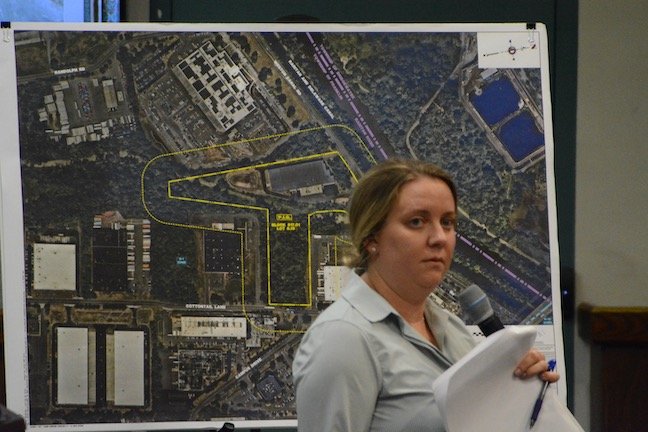Zoning Board Approves 51,000-Square -Foot Warehouse, Despite Township Warehouse Ban

The Zoning Board of Adjustment recently approved a 51,000-square-foot warehouse at Weston Canal Road and Cottontail Lane.
The warehouse application was the first such application heard by a township land use board since the Township Council banned warehouses in early 2023.
The six Board members who voted for the application at the September 5 meeting said they did so because a warehouse fit in with other development in the immediate area, and was not near any residential developments.
Some members were also swayed by the developer’s argument that their application would have been grandfathered under the Township ban if it had not been for a technical glitch that delayed the application being considered complete before the ban went into effect.
The plan, submitted by Somerset Properties, calls for the building to front Cottontail Lane. It will have 24 parking spaces and nine loading docks.
The project will also require the removal of 148 trees, which will result in the replacement of 86 trees when 217 are required, the Board was told. The developer will make a contribution to the township tree fund to cover the shortfall, the Board was told.
The developer also plans to plant 284 shrubs around the property, the Board was told.
Mark Healey, the Township’s principal planner, asked architect Brendan Leadbeater if the warehouse was going to be used as a fulfillment center.
“I think that would probably be up to ownership to potentially answer with regard to the functioning of that, but being that we have nine dock doors and two drive-in doors, I do believe it’s going to be a fairly minor activity in terms of how it functions,” Leadbeater said. “But again, I think that’s more for the ownership to respond to.”
“Could this accommodate, even though it only has nine loading docks for the larger vehicles, could this accommodate a warehouse user where it has a whole bunch of box trucks going out all day long?” Healey asked. “I mean, would it be designed in a different way that this site and building couldn’t accommodate?”
“I mean, typically a building of this size would be for more long-term storage, I believe,” Leadbeater said. “Usually the fulfillment center would be 200,000 to 1 million square feet in size. So typically again I’m not entirely sure who the tenant would be nor am I entirely sure of the you know the intentions. Generally you know again a facility of this size would have lower activity levels.”
Andrew Jafolla, the applicant’s traffic engineer, reinforced the idea that the warehouse could not be a fulfillment center.
“What I can tell you from my experience is that a distribution center would require a whole lot more parking because you would have a whole lot more employees,” he said. “The loading docks would be designed differently. They’d be a little bit lower if you have sprinter vans and delivery vehicles that are coming up.”
“This is very kind of run-of-the-mill warehouse type of use and this this project really fits that that mold,” Jafolla said. “To the size of it, again the distribution would be much larger because they really want to accomplish a lot within one building when they bring all those employees to one spot. So this really does not fit the mold for those higher types warehouse uses or distribution of fulfillment centers.”
Jafolla told the Board that he studied traffic in the several intersections around the property, incorporating nearby projects that have been approved by the Planning Board or are under constyruction.
“When we run all of this through, when we do the pre-development traffic analysis and post-development traffic analysis, this project does not move the needle at all in terms of level of service B,” he said. “Post development, level of service B.”
Paul Grygiel, the project’s planner, told the Board that the warehouse would be “in an area here with a number of commercial, office, industrial, warehouse type uses in the immediate vicinity. A bit further afield you do get into residential again, there’s nothing nearby.”
“You do also have some, again, older office buildings and hotels that have existed here for some time, but there has been a trend, as the Board is well aware, of transitioning some of those uses to other non-residential uses,” he said.
“The abutting properties to the north, south, and west are developed with warehouses or similar type uses as well as many of the properties in the surrounding area,” Grygiel said. “I understand the concerns that the Board and the Township and residents and others may have about warehouse development in areas where you’re closer to residential, but this particular property actually has no such issues.”
“Secondly, with regard to the location, the property has frontage on and access from a road that serves similar uses,” he said. “I know we’ve heard concerns about the traffic from those, but the reality is there’s existing conditions there today, and that’s because you can access an interstate highway interchange a short distance from here without traversing through residential areas, so any concerns about the limited truck traffic that’ll be generated can be mitigated by the fact, again, it’s a direct shot right over to Route 287.”
“If I was being asked to justify a variance of this type elsewhere in the township that was closer to residential or farther away from Route 287, I don’t think I’d have the same opinion or be here before you,” he said. “The road network actually also is adequate to handle employee trips and we actually even have bus stops in front of the site, so there’s the ability for public transit for the users of the facility.”
“It’s certainly not a large-scale warehouse that would have the types of impacts that are being the concern of many people who live nearby such facilities,” he said.
Grygiel told the Board that he thought it interesting that prior to the banning of warehouses in the township, “the township did think that this property was appropriate for warehouse use.”
Board Chairman Robert Thomas noted that this was the first warehouse application since they were banned by the Township Council in 2023.
“It’s not that warehouses are are non-permitted uses in BI zones, they’re non-permitted uses, period,” he said. “And I was looking for a little bit of a compelling argument with some strong support as to why we should be going against the expressed wishes of the Council, and again it’s not the size of the warehouse. I think in my mind you’ve gone a long way to giving me some things, let’s say, that I might be able to hang my hat on in support of this.”
“And the council has decided that they don’t want this use, period, in this town,” he said. “I would think we need a little, maybe we can’t legally do this, but even a little more compelling reason to grant a use variance than we would normally where the use is permitted somewhere else, but you’re looking for a suitable place in a zone that’s not permitted.”
“I think without getting ahead of myself, I don’t know that honestly that you can find a more suitable site for a warehouse,” Thomas said. “I think you have gone a long way with the idea that there doesn’t need to be any truck traffic through any residential area in order for this place to function, which might make it more palatable under the circumstances that they’re actually banned everywhere and they went out of their way to do it. So legally or not, I think that since this is our first application everybody on the Board should think about whether a compelling enough argument has been made to do that, to grant an approval because this is a use that was taken away and specifically taken away. So if we approve it, in a sense you could say we are impacting the Master Plan.”
Lane Miller, the applicant’s attorney, told the Board that it has to “consider the proofs in front of you and I suggest that the proofs that have been presented through the testimony, the size of the warehouse which is quite modest as warehouses go, the location and proximity to the roadways, the nature of every other existing use there in this location, all argue strongly in favor of granting the use variance because you’re not going to see another situation, another property presented that’s anywhere close to this.”
The motion to approve the application, with the condition that the warehouse not be used as a fulfillment center, was made by Board member Alan Rich and seconded by Board member Joel Reiss.
Board members Rich, Reiss, Thomas, Gary Rosenthal, Vaseem Firdaus, and Faraz Khan voted for the application.
In voting “no,” Board member Michael Doughtery said, “I do not think that there was a compelling enough argument that clearly should disavow the clear intent of the council and the ordinance.”























































